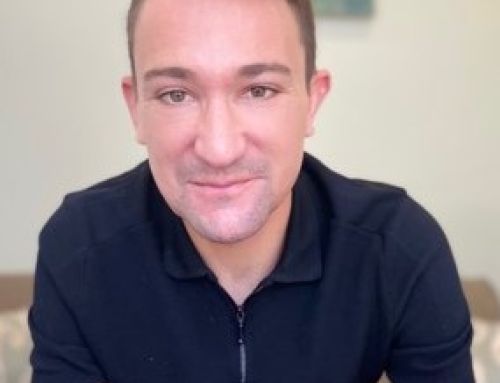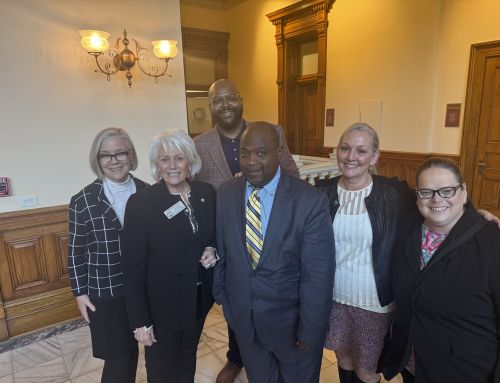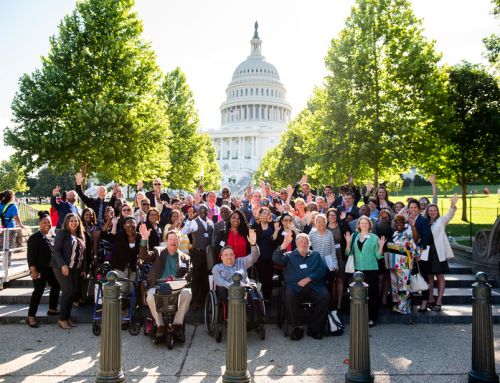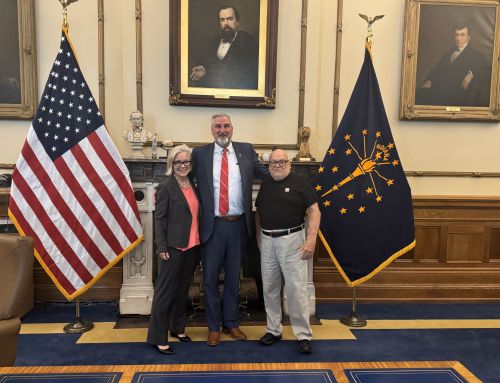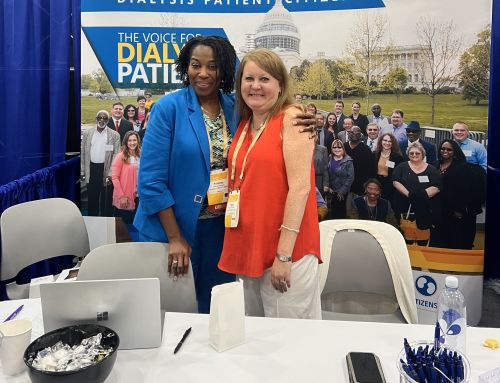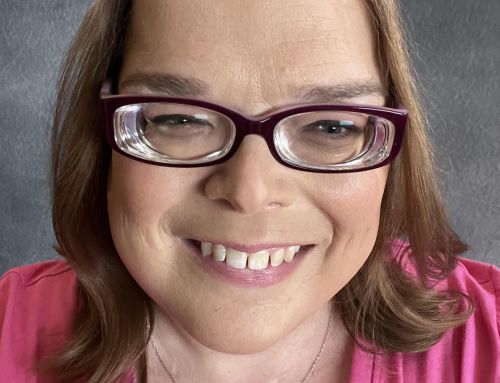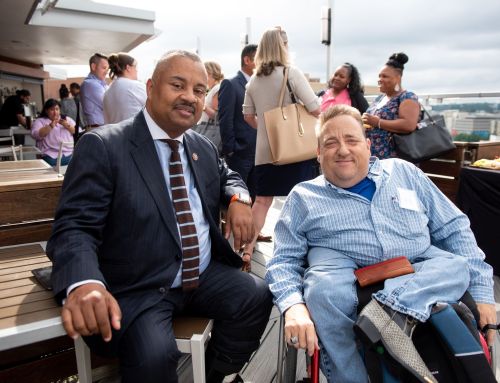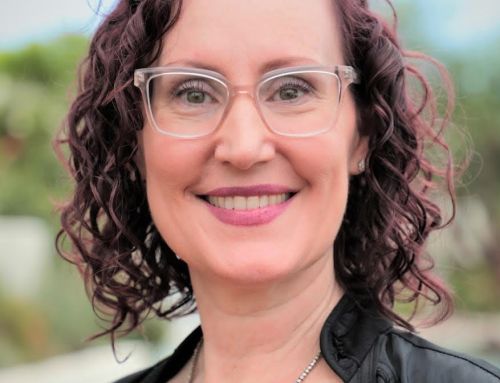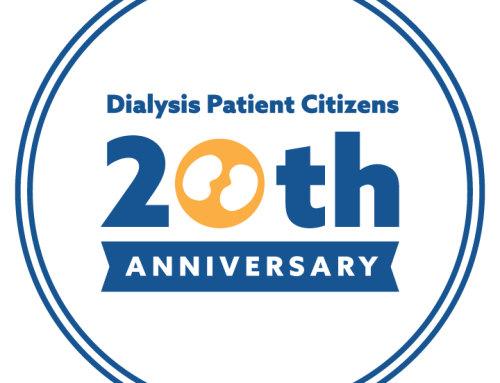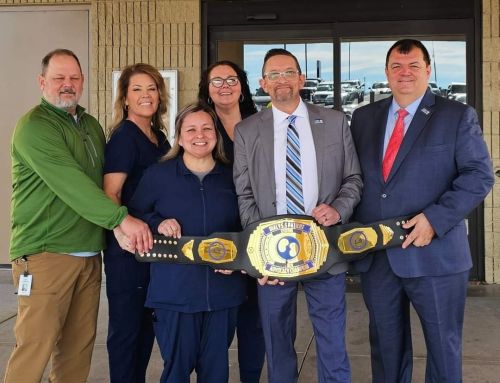August 18, 2023
Hon. Chiquita Brooks-LaSure, Administrator
Centers for Medicare & Medicaid Services
7500 Security Boulevard
Baltimore, MD 21244
Re: End Stage Renal Disease (ESRD) Prospective Payment System (PPS) Calendar Year (CY) 2024 Proposed Rule (CMS-1782-P)
Dear Administrator Brooks-LaSure:
Dialysis Patient Citizens (DPC) writes to offer its comments on the above referenced proposed rule.
DPC’s membership, currently about 35,000, is restricted to kidney disease patients and their family members. DPC is a patient-led organization. Our by-laws require that the President, Vice President and at least 51% of the Board be current dialysis patients. The non-dialysis patients serving on our Board are former dialysis patients with kidney transplants. Our volunteer board members have represented their peers on CMS technical expert panels and/or advisory committees of other health care organizations such as the National Quality Forum and Patient-Centered Outcomes Research Institute. DPC also conducts periodic Membership Surveys to ascertain patients’ experiences with their care and views on health policy issues. DPC is committed to promoting access to high-quality dialysis care for individuals with ESRD; to prevention of, delayed onset of, and safe transition to ESRD among individuals with chronic kidney disease; and access to kidney transplantation as well as to other alternatives to dialysis that may emerge.
I. Workforce Issues in the ESRD Prospective Payment System
A very disturbing aspect of this Rule is its refusal to acknowledge changes to labor markets over the past two years that are obvious to everyone from economists and statisticians to average Americans waiting for delayed services, whether at a restaurant, an airport baggage carousel, or a health care facility. It is one thing for the Agency to delegate the function of applying indexes to a market basket to a contractor; it is another for stewards of a critical government program to accept the contractors’ work with no discussion or acknowledgement of historic changes to our economy and the dire effect they can have on patients if not addressed.
Workforce shortages are beginning to impact patient care. Media reports indicate numerous instances of hospitals declaring “contingency standards of care,” or ordering ambulance diversions, due to staffing shortages. CMS needs to act before such practices become commonplace in dialysis facilities. Most Medicare beneficiaries who are infrequent users of health care facilities will probably have no idea when care is not delivered to standards, but ESRD patients will know if their dialysis prescriptions can’t be followed, as well as the health consequences.
Nearly every year since 2013, DPC has conducted member surveys. Our first survey asked numerous questions and established a baseline from which we can observe trends. The trends we are seeing are most concerning:
- In 2013, in response to a question about wait times at facilities, the same proportion of patients, 14%, reported increases in wait times as decreases in wait times. This year, 24% report increases in wait times and only 11% reported decreases.
- In 2013, we asked patients whether “in the past year, has time spent with health care providers (nurses, technicians) in your primary dialysis center increased, decreased, or stayed the same.” Ten years ago, only 13% reported the time had decreased; this year it was 26%.
- This year, we asked patients whether the recent labor shortages had impacted their care. 62% of patients reported that it had: 43% said that staff turnover disrupted their care; 28% reported delays to their treatment; and 7% reported that they had to change shifts or facilities.
Anecdotal stories from patients illustrate how Medicare beneficiaries perceive these changes:
From Houston Texas: The clinic that I go to is overall a very good clinic. I have been going to the same clinic for the past 4 yrs. I love the staff. However I have seen the atmosphere change within the last 6 months. A few of the good knowledgeable employees have left for better opportunities. As a patient I have become comfortable with them. It is hard as a patient to get used to a new employee sticking you with needles, not everyone knows how to stick well. Also I have seen other clinics close and schedules have to be readjusted. Sometimes my clinic is short staffed that the employees may have to shorten their vacations. To me if the staff is not being paid well and on time it will lower the morale in the clinic and also the staff will get burned out quickly. I personally have not had to reschedule or come in at a different time yet. But I have seen it happen to other patients and they were not happy.
From Zimmerman, Minnesota: Our center has been short staffed for over two years now. Many of the staff at dialysis centers in my area are floating from one clinic to another. We have staff at times who do not even know the patients they are helping for the day. I have been on dialysis for close to 21 years and get nervous when I walk into my clinic and see a strange face. I will not let that technician do my needles or monitor me until I tell them what problems I can have during treatment. Our normal staff is very good, they are overworked and at times one does get concerned about the care we receive because of the long hours they put in. They are devoted girls.
From Bessemer, Alabama: They are continually having a large turnover of techs and nurses here and because of that treatment has been poorer and slower. We have good nurses and techs but our center just does dialysis Monday, Wednesday, and Fridays. Without Medicare paying more I see more dialysis centers going under.
According to the BLS Employment Cost Index for March 2023, wages and salaries increased 5.0 percent for the 12-month period ending in March 2023 and increased 4.7 percent for the 12-month period ending in March 2022. Benefit costs increased 4.5 percent over the year and increased 4.1 percent for the 12-month period ending in March 2022. The wage increase was 6.0 percent for workers in service occupations. Between this year’s paltry update, and deficient updates in previous years that leave providers 4 percentage points behind actual cost increases, payments to dialysis facilities are lagging behind changes in the labor market, threatening patient access.
We note that the 2.0% market basket forecast by CMS’ contractor does not jibe with others.’ McKinsey/Oxford Economics, who observe a “worsening clinical labor shortage,” issued projections for health care labor inflation at 10% for 2022, 6% for 2023, and 3.5% for each year thereafter.
It is clear that the American workforce as a whole is not large enough to fill all the open positions in our economy. Currently there are 9.8 million job openings in the U.S., but only 5.9 million unemployed workers. It also appears that Medicare’s traditional price-setting processes are not agile enough to adapt to today’s unusual conditions. Medicare’s administered pricing system has never had to deal with labor scarcity before. CMS must be creative in developing and implementing policies that respond to these perilous conditions, on an urgent basis before the inconveniences being faced by patients spiral into harm. Because dialysis facilities are so reliant on Medicare—and are likely to become more so, given the Supreme Court’s decision to follow CMS’ interpretation of the Medicare Secondary Payer Act—patients need CMS’ payments to accurately account for labor costs.
Matthew Fiedler of the USC-Brookings Schaeffer Initiative for Health Policy notes that when annual payment updates do not account for prior forecast errors, “Medicare’s prices will not experience significant ‘catch-up’ growth. A corollary is that the real prices Medicare pays for most health care services will remain on a permanently lower trajectory than they would have been if the current period of elevated inflation had not occurred.”
We find this prospect frightening. Vulnerable patients need a labor market in which there is a one-to-one ratio of health care workers for vacancies in essential jobs. Over the long term, the government may need to act to foster interest among young people in healthcare careers and facilitate their preparation for such roles. But in the immediate term, it is necessary to ensure that wages for jobs like dialysis technicians are competitive. Jobs that are challenging and require in-person performance at a fixed workplace will likely require a premium in salary over those that do not require commuting. The Wall Street Journal recently reported that head counts at firms allowing at least one day of remote work increased 5% in May 2023 from June 2022, while those at fully in-person companies gained only 2.6%, on average. Further, jobs with rigid pre-set salary schedules, that can’t adjust to quickly evolving circumstances, will be disfavored by those seeking work. We worry that employee pay reliant on annual Medicare payment adjustments too closely resembles this situation.
We also are concerned that if it becomes widely known that Medicare payments have been hobbled in perpetuity, health care careers will become undesirable to young people. Would the Agency want Matthew Fiedler’s observation circulated among career counselors and others who advise young adults on career paths?
Over the next decade, the number of people of working age (between 15 and 65) will decline by 3.2%, according to World Bank projections. A recent report from Indeed and Glassdoor observes “Fewer people of working age mean the supply of workers will dwindle. Combine this aging population with other trends, such as reduced immigration, and the stage is set for chronic recruiting challenges.” The report notes that US population growth will be driven solely by net migration from outside.
“Despite looming talks of recessions, Indeed and Glassdoor economists believe that hiring will remain challenging for years to come, driven by demographics and evolving preferences. Workers will continue to have the leverage to press for higher pay, stronger benefits, scheduling flexibility, and a variety of other perquisites.”
Like Kidney Care Partners, we would prefer that CMS correct the deficient updates by applying actual, historical numbers. Expecting future errors to offset these extreme underpayments is tantamount to predicting lightning will strike twice in the same place. Such a scenario seems to contemplate not only the oft-predicted recession that keeps eluding forecasters, but a slowdown closer to a major depression.
However, we are willing to suggest an alternative approach—rather than recalculating all errors to the market basket, the Agency could institute a sort of circuit-breaker to ensure that health care professions are not permanently disadvantaged by miscalculations made during this extraordinary period. We would suggest this concept be applied to the hospital forecast errors as well; our members experience, on average, between 1 and 2 hospitalizations each year.
We propose an Essential Worker Safety Catch, to look back on previous updates, and reconsider current forecasts, so updates are trued up and don’t fall behind actual changes in compensation. This would incentivize young adults to continue to consider health care careers and ensure that the health care sector is not disadvantaged in attracting and retaining workers. The Agency mustn’t allow deficient updates from the distant past to drag down compensation in perpetuity. CMS can monitor cost reports to confirm that the added dollars are spent on paying frontline workers and not going to pad profits. We have reached a point where, rather than defaulting to parsimonious payments and then waiting for reports of access problems, it would be safer for CMS to err on the side of generous payments.
The Agency must also begin to consider the impact that income inequality will have on health workforce and healthcare access. A March 4th New York Times article described the trend toward “premiumization” in our economy—“As products grow more expensive and exclusive, big swaths of the economy are at risk of becoming gentrified, raising the possibility that poorer consumers will be increasingly underserved.” The example of this that is best known is automakers cutting inexpensive, economy models to focus on marketing more profitable big-ticket models to wealthier consumers.
In the healthcare sphere, the fear is that, as Frank Pasquale suggested in a law review article, “disparities in buying power [will divert] essential resources from the poor” as “the well-off bid away resources and opportunities from the poor.” The examples where this is already taking place, he notes, are so-called “concierge” medical practices and physicians concentrating on cosmetic procedures.
Currently, 69% of the wealth in the U.S. belongs to just 10% of the population. The lowest 50% of households own just 2.4% of total wealth. Dialysis patients are overrepresented in the latter demographic.
Historically, the Medicare program has maintained egalitarian access among beneficiaries through “social minimum” mechanisms such as the ban on balance billing by participating physicians, and EMTALA; and “ceilings” of care such as the ban on buying and selling organs. But these principles can’t be upheld if health care providers can pay only below-market wages.
A common sight at airport security lines is representatives of Clear Secure, Inc., a service that allows wealthy travelers to pay a fee to skip to the front of the queue. Employers such as Clear are increasingly competing with healthcare providers for the same pool of potential workers. The worst-case scenario for the Medicare program is that providers reliant on Medicare reimbursements won’t be able to compete with employers able to draw revenue from that 10% of the population holding most of the wealth, and manpower will migrate to work with less social utility.
It is imperative that the challenging work performed by healthcare occupations be compensated in proportion to its value to patients and to society as a whole. This requires departing from rote application of stale data and forecasts developed for an era when labor was plentiful. It means a commitment that essential healthcare occupations are not less remunerative nor as remunerative but more remunerative than non-essential jobs, in accord with American values of compassion and belief that access to health care should be available to all, not just the wealthy. In a worst-case scenario, dialysis clinics and hospitals serving low- and middle-income patients could be unable to hire staff as a parallel, go-to-the-front-of-the-line health care system emerges to serve the well-off.
II. Payment for Innovative New Products.
In order to mitigate the excesses of allowing dialysis facilities to separately bill for items, Congress enacted the ESRD PPS. But bundled payments come with their own perverse incentives. Medicare beneficiaries rely on CMS mitigate those perverse effects. The Agency has dragged its feet in acknowledging and remedying potential harms to beneficiaries.
There are two main categories of perverse effects in the ESRD sphere: disincentives for manufacturers to develop and market improvements to ESRD care, and incentives for providers to stint.
We have grave concerns about how patients are experiencing the rollout of Korsuva, the drug that treats pruritis. The prescribing behavior of nephrologists has amounted to, in effect, a de facto embargo of the medication.
Empirical research has found a prevalence of moderate to severe pruritis among dialysis patients of 33 percent, but Korsuva is being dispensed to fewer than one percent of patients. And now, the Agency proposes to use the artificially low take-up during the TDAPA period to add a tiny amount to the bundle, thereby locking in a depressed rate of utilization in perpetuity.
It is believed that one reason nephrologists are reluctant to prescribe the drug is fear of having to take it away from patients when the payment cliff arises at the end of the TDAPA period.
The typical prescribing scenario in Medicare is that doctors have no disincentive to prescribe and may be incentivized to overprescribe. When prescriptions are paid for by a Part D PDP, PDPs can use formularies or prior authorization to restrict expensive drugs. In such cases, doctors act as advocates for their patients in obtaining the drug. In the ESRD sphere, however, nephrologists are frequently in joint ventures with dialysis clinics and incentivized to keep utilization of bundled drugs low. It appears that nephrologists are not acting as advocates for patients with pruritis.
Thus, there are two problems facing patients here: a system that incentivizes neither the development or uptake of innovative therapies; and the possibility of stinting by providers who receive a fixed payment.
We think it fundamentally unfair that dialysis patients can miss out on opportunities for improved care because they are subject to a payment bundle and global budget. Since Medicare Parts B and D are not subject to payment bundling or global budgets, patients with other chronic diseases have access to new treatments regardless of whether those treatments even improve outcomes.
The Agency must recognize that the policy of spreading the payment for expensive drugs used by fewer than all of ESRD patients across all patients is not tenable. As we have stated before, such drugs must return to being separately billable in order to protect patients. In the meantime, there must be a standardized appeals process for denial of bundled drugs, clearly communicated to beneficiaries. At this time, we have no visibility into how many patients even know that Korsuva exists and is potentially available; we suspect the number is few, given that providers have no incentive to communicate its benefits, which presents further problems. We hope that CMS will be proactive in monitoring and addressing this issue.
III. Quality Incentive Program Issues
When it comes to policies to address equity and social determinants of health, mere symbolism does not suffice; only a commitment of new funding to compensate for disadvantages will move the needle on outcomes. Further, we believe pay-for-performance programs are a particularly inappropriate vehicle for addressing equity and health-related social needs.
As we have pointed out in previous comments, academic experts have criticized the QIP measure set as sprawling and unfocused. The changes proposed in this Rule would further dilute the QIP’s ability to incentivize clinical quality by adding items—we hesitate to call them measures—to symbolize recognition of important health policy priorities.
CMS is proposing to add a Facility Commitment to Health Equity reporting measure to the ESRD QIP measure set beginning with PY 2026. This item is intended to assess an ESRD facility’s commitment to health equity based on its responses to five equity related attestation-based questions.
In this case, a quality program is being used as a back-door mandate, essentially imposing regulation directing providers to perform a specific activity. This is in contrast to outcome measures, such as the hospitalization ratio, which hold providers accountable for an important ultimate outcome but give them flexibility in how to achieve the goal.
The Rule also proposes adopting the Screening for Social Drivers of Health measure. While poor outcomes associated with SDOH are surely a “quality problem,” it does not necessary follow that it is a problem amenable to improvement through a quality measure, nor this one in particular.
We note that, first, this item makes an assumption that the presence of health-related social needs is best ascertained through use of a “standardized tool,” and not through a probing, if informal, interview by a practitioner, nor through predictive modeling (such as making inferences about HRSNs from the patient’s address). We are not aware of evidence showing the superiority of this method; it is too early to penalize providers for using alternative means. Second, while there is intuitive appeal to the idea of charging providers with the responsibility of detecting HRSNs and referring patients to public programs or community resources, there is great variability from place to place in the availability of such services. Thus far, this technique has been employed as part of a broader HRSN demonstration that involved community organizations as participants. We have no idea what would ensue in deprived areas that lack such resources, and would not want clinics futilely administering questionnaires.
The HRSN screening measures are aimed at preventing avoidable hospitalizations, which is already part of the QIP; and reducing mortality, which dialysis providers are already financially incentivized to do. We suspect that when HRSN screenings and appropriate referrals will help achieve better outcomes, providers are already motivated to perform them.
These items are conditions, not measures. It is CMS’ prerogative to require compliance with conditions from program participants, but quality measures should be focused on areas of clinical quality, graded on a continuum that permits consumers to make meaningful comparisons. We do not favor P4P programs departing from that goal.
CMS is also proposing to add the Screen Positive Rate for Social Drivers of Health reporting measure to the ESRD QIP measure set. The values for this item, if reported, will give consumers zero insight into the quality of a facility’s care. Consumers would surely interpret the values according to their own biases and preconceptions. We think a good rule of thumb would be, if CMS can’t say whether a higher value means better or worse for beneficiaries, the Agency should not collect or report it.
As we have stated before, we believe a better approach to SDOH and disparities is to offer a supplemental payment to facilities serving disadvantaged patients in return for a facility’s commitment to use the additional money to address HRSNs such as food security and inadequate transportation that are particularly relevant to ESRD care. Instead, clinics serving the disadvantaged are receiving QIP penalties caused by social determinants, not poor quality of care. The Agency has moved in the right direction by offering supplemental payments in its new Oncology Model and offering more favorable benchmarks to ACOs serving disadvantaged patients. We await a similar initiative for ESRD patients.
Thank you for your consideration of our comments and concerns. If you have any questions or would like additional information, please do not hesitate to contact me or our Vice President of Public Policy Jackson Williams (at 202-768-4506 or jwilliams@dialysispatients.org).
Respectfully submitted,
Hrant Jamgochian, J.D., LL.M.
Chief Executive Officer


